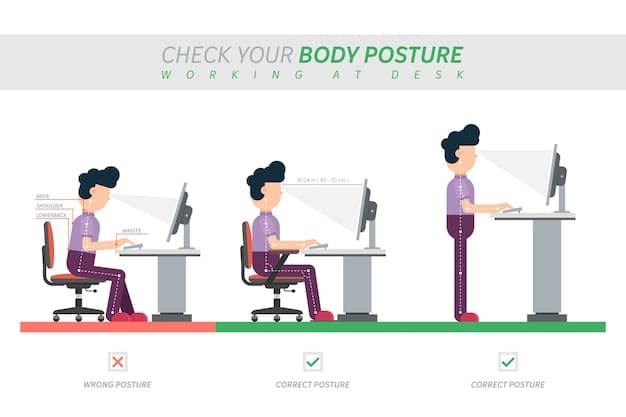Gaming Chairs: Hype or Worth It? Expert Analysis & Alternatives

The true value of gaming chairs lies in their ergonomic design and support tailored for prolonged sitting, though their worth is often debated against traditional office chairs given the significant marketing hype surrounding them; expert analysis suggests a balanced view, considering individual needs and budget for optimal comfort and health.
In the expansive and ever-evolving world of PC gaming, discussions about optimal setups often extend beyond just powerful GPUs and lightning-fast processors to encompass every aspect of the play experience, including the chair you sit in. Few topics ignite as much debate in the gaming community as The Truth About Gaming Chairs: Are They Worth the Hype? Expert Analysis and Alternatives, a question that permeates forums, product reviews, and countless YouTube videos.
The Evolution of Gaming Chairs: From Office Staples to Racing Seats
The journey of the gaming chair from a niche market item to a ubiquitous presence in streamers’ setups and competitive gaming arenas is a fascinating narrative. Originally, gamers simply adapted whatever seating they had available, typically standard office chairs. However, as gaming sessions grew longer and professional esports began to demand peak performance and endurance, a need arose for specialized seating.
The earliest iterations of what we now recognize as gaming chairs drew heavy inspiration from racing car seats. This design choice was primarily aesthetic, mimicking the aggressive, sporty look associated with speed and adrenaline. Lumbar pillows, neck supports, and exaggerated side bolsters became defining features, creating a distinctive silhouette that quickly became synonymous with “gaming” furniture.
Design Philosophy and Ergonomic Claims
Many manufacturers position gaming chairs as ergonomically superior to their office counterparts, touting features like high backs for full spinal support, adjustable armrests for precise aiming, and tilt mechanisms for reclining. The argument often centers on preventing back pain and promoting better posture during extended gaming sessions. However, the efficacy of these claims is often scrutinized.
- High Backrests: Designed to support the entire spine, from the lumbar region up to the neck and head.
- Adjustable Components: Including armrests (2D, 3D, 4D), seat height, tilt tension, and recline angles.
- Lumbar and Neck Pillows: Often detachable, intended to provide customizable support for key areas.
While these features are indeed present, their actual ergonomic benefit varies widely depending on the chair’s construction quality, the user’s body type, and their understanding of proper adjustment. A chair packed with features doesn’t automatically equate to superior comfort or health benefits if not properly utilized.
The early market was largely driven by aesthetics and the perceived “coolness” factor, with aggressive styling and vibrant color schemes dominating. This initial focus sometimes overshadowed the underlying ergonomic science, leading to a proliferation of chairs that looked impressive but offered questionable long-term comfort or postural benefits. Understanding this historical context is crucial when evaluating the current market and the genuine value proposition of these chairs.
Deconstructing the Hype: Marketing vs. Real-World Performance
The gaming chair market is saturated with brands, each vying for consumer attention with bold claims and celebrity endorsements. This intense competition has fueled a marketing machine that often prioritizes appearance and aspirational lifestyle over substantive ergonomic benefits. Deciphering the actual value from the pervasive hype requires a critical eye.
Many gaming chairs are aggressively marketed as essential tools for competitive advantage, implying that owning one will directly improve your gameplay. While comfort undoubtedly contributes to focus and endurance, a chair alone cannot compensate for skill or strategy. This marketing tactic often preys on the desire of gamers to optimize every aspect of their setup, sometimes leading to impulsive purchases based more on perception than an informed decision.
Common Misconceptions and Exaggerated Benefits
One of the most frequently heard arguments for gaming chairs is their supposed ability to prevent back pain and improve posture. While a properly adjusted ergonomic chair can certainly aid in this, many gaming chairs, particularly those on the lower end of the price spectrum, use designs that are more about visual appeal than genuine anatomical support. The ubiquitous “bucket seat” design, while visually striking, often forces an unnatural posture for prolonged periods, especially for individuals who don’t fit the chair’s one-size-fits-all dimensions.
Material quality also plays a significant role. Many affordable gaming chairs use PU leather, which can feel premium initially but often degrades quickly, cracking and peeling over time. The foam padding inside can also compress and lose its supportive properties, leading to discomfort rather than relief. Higher-end models may use breathable fabrics or genuine leather, coupled with higher-density foams, but these come at a much steeper price point, blurring the line between a “gaming chair” and a high-quality ergonomic office chair.
- Aggressive Styling: Often prioritizes aesthetics over true ergonomic principles.
- Material Durability: PU leather can be prone to cracking and peeling, challenging long-term comfort.
- Universal Fit Fallacy: Design may not suit all body types equally, leading to discomfort.
The truth is, many of the features touted as revolutionary in gaming chairs — like high backs and adjustable armrests — have been standard in quality ergonomic office chairs for decades. The “gaming” distinction often boils down to a specific aesthetic and marketing narrative rather than a fundamental breakthrough in ergonomic design. Consumers should be wary of claims that sound too good to be true and instead focus on validated ergonomic principles and durable construction.
Expert Analysis: What Ergonomists and Health Professionals Say
When evaluating the efficacy of gaming chairs, it’s crucial to consult the perspectives of ergonomists, physical therapists, and other health professionals who specialize in posture and musculoskeletal health. Their insights often diverge from the marketing narratives, offering a more nuanced and evidence-based view on what constitutes healthy seating.
Many experts emphasize that the most important aspect of any chair, whether for gaming or office work, is its adjustability and how well it fits the individual user. A chair, no matter how expensive or “gaming-specific,” cannot provide optimal support if it doesn’t align with the user’s body dimensions and allow for dynamic movement. Static postures, even in a seemingly supportive chair, can lead to discomfort and long-term issues.

Key Ergonomic Principles for Seating
Ergonomists generally advocate for chairs that promote a neutral spinal alignment, allow the feet to be flat on the floor (or supported by a footrest), and keep the arms at a comfortable height, parallel to the desk. Features like adjustable lumbar support that can be placed precisely where the user needs it, instead of fixed pillows, are often highlighted as more beneficial. Seat depth adjustability is also critical to ensure proper thigh support without pressure on the back of the knees.
- Customizable Lumbar Support: Crucial for maintaining the natural curve of the lower back.
- Adjustable Seat Depth: Ensures proper leg support and prevents pressure points.
- Breathable Materials: Enhances comfort during extended sitting, preventing heat buildup.
Furthermore, health professionals consistently stress the importance of movement. Even the best ergonomic chair cannot negate the negative effects of prolonged, uninterrupted sitting. Regular breaks, stretching, and incorporating movement into the routine are as, if not more, important than the chair itself. A chair should facilitate a healthy posture, but it should not be seen as a magic bullet to solve all sedentary-related health issues.
In conclusion, expert consensus suggests that while some gaming chairs may offer decent ergonomic features, they often fall short when compared to high-quality ergonomic office chairs designed with scientific input. The “racing seat” aesthetic, while popular, can sometimes compromise true ergonomic principles. Prioritizing adjustability, build quality, and personal fit over flashy designs is the advice consistently offered by those focused on long-term health and comfort.
The Practical Realities: Durability, Price, and User Experience
Beyond the hype and ergonomic claims, the real-world value of gaming chairs is often defined by their durability, price point, and the actual user experience over time. These practical considerations can significantly influence whether a gaming chair truly lives up to its promise for individual users.
Durability is a frequent concern, especially with lower to mid-range gaming chairs. The extensive use of synthetic materials like PU leather and less robust internal components can lead to premature wear and tear. Armrests can become wobbly, hydraulic lifts can fail, and padding can lose its density, rapidly diminishing the chair’s comfort and support. This can lead to a cycle of needing replacements sooner than expected, offsetting any initial cost savings.
Price-Performance Ratio and Value Proposition
When it comes to price, gaming chairs span a wide spectrum, from budget-friendly options under $200 to premium models exceeding $1000. However, the correlation between price and actual ergonomic benefit or durability is not always linear. Some mid-range chairs might offer better value than more expensive, but poorly designed, alternatives. Conversely, some high-end gaming chairs deliver on quality but come at a price point where truly superior ergonomic office chairs become accessible.
- Material Quality: Impacts both comfort and longevity.
- Component Reliability: Crucial for the chair’s functional lifespan.
- Warranty and Customer Service: Indicators of manufacturer confidence in their product.
User experience is highly subjective, but common themes emerge from reviews and community discussions. Many users initially enjoy the distinctive look and perceived comfort of a gaming chair. However, over extended periods, some report discomfort, particularly around the neck and lower back, often due to the fixed design of the lumbar and neck pillows or the constraining nature of the bucket seat. The breathability of materials also affects long-term comfort, especially in warmer climates or during intense gaming sessions.
Ultimately, a gaming chair’s worth is a personal equation balancing individual comfort, aesthetic preference, budget, and the chair’s longevity. It’s an investment, and like any investment, it requires careful consideration of the practical realities rather than solely relying on marketing promises or the opinions of competitive gamers who might have different needs and sponsorship considerations.
Exploring the Alternatives: Superior Ergonomics for Gamers
For those questioning the true value of gaming chairs, a robust market of alternatives offers potentially superior ergonomic support tailored for long hours at a desk, whether for gaming, work, or general use. These alternatives often prioritize scientific ergonomic principles over stylized aesthetics, focusing on adjustability, support, and durability.
The most prominent alternative is the high-quality ergonomic office chair. Brands renowned for their office seating have decades of research and development invested in creating chairs that promote healthy posture and comfort for prolonged sitting. These chairs typically offer extensive adjustability, including highly customizable lumbar support, seat pan slides, multi-directional armrests, and advanced tilt mechanisms, allowing users to fine-tune the chair to their specific body type and preferences.
Types of Ergonomic Office Chairs and Their Benefits
There are various types of ergonomic office chairs, ranging from task chairs designed for active engagement to executive chairs offering more plush comfort. Key benefits often include breathable mesh materials that prevent heat buildup, high-density foam padding that retains its shape, and robust construction backed by substantial warranties. While they may lack the “sporty” aesthetic of gaming chairs, their focus on health and long-term comfort often outweighs the visual appeal for many users.
- Advanced Adjustability: Allows for precise fitting to individual body measurements.
- Scientifically-Backed Design: Developed with input from ergonomics experts.
- Superior Materials: Often use breathable fabrics, high-quality foam, and sturdy frames.
Another increasingly popular alternative is the standing desk. While not a chair, it addresses the fundamental issue of prolonged sitting by allowing users to alternate between sitting and standing throughout the day. Many health professionals advocate for this dynamic approach to reduce the negative health impacts associated with sedentary lifestyles. When combined with a good ergonomic chair for sitting periods, a standing desk offers a powerful solution for maintaining comfort and health.
Even for those on a tighter budget, investing in a decent ergonomic office chair from a reputable brand, even a used one, can often provide more ergonomic value than a similarly priced basic gaming chair. The key is to prioritize adjustability, build quality, and good spinal support. Ultimately, the best “gaming chair” might not be one explicitly marketed for gaming, but one designed to provide optimal ergonomic support for your unique physique and sitting habits.
Making an Informed Decision: Factors to Consider Beyond the Hype
Navigating the complex landscape of gaming chairs and their alternatives requires a thoughtful approach, focusing on individual needs rather than being swayed by marketing hype. Making an informed decision involves a careful evaluation of several critical factors that extend beyond just aesthetics or brand loyalty.
Firstly, prioritize ergonomics over design. While a chair’s appearance might be appealing, its primary function is to support your body for extended periods. Look for features that genuinely contribute to good posture and comfort: adjustable lumbar support that can be positioned to fit the curve of your lower back, a seat depth that correctly supports your thighs without cutting off circulation, and armrests that can be set to allow your arms to rest comfortably at a 90-degree angle to your desk.
Key Decision-Making Criteria
Consider your personal body type and gaming habits. Are you tall, short, large, or small? Do you game for one hour a day or ten? A chair that fits a professional esports player might not be suitable for a casual gamer with different physical dimensions. Always check the chair’s specifications regarding weight and height limits, and ideally, try out the chair in person if possible. Prolonged sitting requires different support than short bursts, so consider the duration of your typical sessions.
- Personal Fit: Ensure the chair’s dimensions suit your body type.
- Sitting Duration: Long sessions demand higher ergonomic quality.
- Budget vs. Investment: View the chair as a long-term health investment.
Durability and material quality are also paramount. A higher upfront cost for a chair made with premium materials like high-density foam, strong metal frames, and breathable fabrics often translates to a longer lifespan and sustained comfort, making it a better long-term investment. Read user reviews focusing on how chairs hold up over time, not just initial impressions.
Finally, remember that no chair can fully compensate for a sedentary lifestyle. Incorporate regular breaks, stretching, and physical activity into your routine. A great ergonomic chair is a tool to support your health during sitting, but it should be part of a broader commitment to well-being. By considering these factors comprehensively, you can move beyond the hype and choose seating that truly enhances your gaming experience and supports your long-term health.
The Future of Gaming Chairs: A Blended Approach?
As the gaming industry continues to mature and consumer awareness around health and ergonomics grows, the future of gaming chairs appears to be leaning towards a more blended approach, combining the popular aesthetics with genuinely sound ergonomic principles. Manufacturers are beginning to recognize that relying solely on racing-inspired designs and marketing hype may no longer suffice for a discerning market.
We are already seeing a shift in design, with some newer “gaming” chairs adopting more features traditionally found in high-end office chairs. This includes more subtle, professional aesthetics, combined with highly adjustable components such as multi-axis lumbar support systems, wider seat pans, and superior material choices like genuine leather or advanced mesh fabrics. The emphasis is moving from superficial flair to tangible comfort and health benefits.
Emerging Trends and Innovations
Technological integration is another area of potential growth. Imagine chairs with built-in sensors that monitor your posture and provide real-time feedback, or heating/cooling elements for enhanced comfort during intense sessions. Haptic feedback chairs, already available in niche markets, could become more mainstream, offering immersive vibrational responses to in-game actions.
- Refined Ergonomics: Incorporating more advanced postural support mechanisms.
- Hybrid Designs: Merging gaming aesthetics with office chair functionality.
- Smart Features: Integration of sensors, feedback systems, and climate control.
Furthermore, sustainability and customization are likely to play larger roles. Consumers are increasingly environmentally conscious, pushing manufacturers towards more sustainable materials and production processes. The demand for chairs that can be tailored not just in terms of adjustability but also in modular components, allowing users to swap out parts or upgrade, could also increase.
The gaming chair market is poised for evolution. While the “bucket seat” may always have a place due to its iconic status, the industry’s progression towards more ergonomically sound, technologically advanced, and user-centric designs suggests a future where the hype begins to align more closely with practical value and long-term health benefits for gamers worldwide. The ultimate goal remains a chair that supports peak performance, comfort, and well-being for any extensive gaming session.
| Key Point | Brief Description |
|---|---|
| 🎮 Hype vs. Reality | Gaming chairs are heavily marketed on style; ergonomic benefits often overstated. |
| 🩺 Expert View | Ergonomists prioritize true adjustability & individual fit over aesthetic design. |
| 💡 Alternatives | High-quality ergonomic office chairs or standing desks often offer better value. |
| 💰 Informed Choice | Consider durability, price, and personal needs to make a wise investment. |
Frequently Asked Questions About Gaming Chairs
▼
Not necessarily. While gaming chairs often feature high backs and lumbar/neck pillows, their “racing seat” design can sometimes promote static, unhealthy postures. High-quality ergonomic office chairs, designed with extensive research, typically offer more precise and customizable support to maintain neutral spinal alignment, which is generally more beneficial for long-term back health than many standard gaming chairs.
▼
The primary distinction often lies in design philosophy and aesthetic. Gaming chairs typically feature bold, racing-inspired aesthetics with aggressive styling and vibrant colors. Ergonomic office chairs prioritize function over form, focusing on subtle design with maximum adjustability and support based on ergonomic science to suit a wider range of body types and promote healthy sitting during prolonged use periods.
▼
The price of gaming chairs is influenced by several factors: strong branding and marketing, licensing deals (for esports teams or game franchises), and the cost of perceived “premium” materials like PU leather or unique design elements. While some high-end gaming chairs offer good build quality, a portion of the cost in the broader market reflects aesthetic appeal and brand hype rather than inherent ergonomic superiority or advanced engineering.
▼
If purchasing a gaming chair, prioritize genuine adjustability: look for 3D or 4D armrests, a seat that can tilt and slide forward/backward (seat depth adjustment), and a sophisticated tilt mechanism. Ideally, also seek adjustable lumbar support that moves independently of the backrest, and ensure the chair’s dimensions (height, weight capacity, seat width) closely match your body type for proper fit and support.
▼
Yes, absolutely. Many entry-level to mid-range ergonomic office chairs can offer significantly better ergonomic support and durability than similarly priced gaming chairs. Brands like AmazonBasics, IKEA, or gently used chairs from reputable office furniture manufacturers often provide solid lumbar support, adjustable components, and breathable materials, proving to be cost-effective solutions for comfortable and healthy seating.
Conclusion
The debate surrounding The Truth About Gaming Chairs: Are They Worth the Hype? Expert Analysis and Alternatives reveals a landscape where marketing often overshadows true ergonomic value. While gaming chairs offer distinctive aesthetics and undeniable appeal, their ergonomic benefits are frequently surpassed by the thoughtful design of high-quality office chairs. Making an informed choice involves looking beyond the racing stripes and flashy designs to prioritize adjustability, material quality, and, most importantly, how well a chair accommodates your unique body and prolonged sitting needs. Ultimately, the best investment in your gaming setup might be a chair that supports your health as much as your passion, regardless of its “gaming” label.





